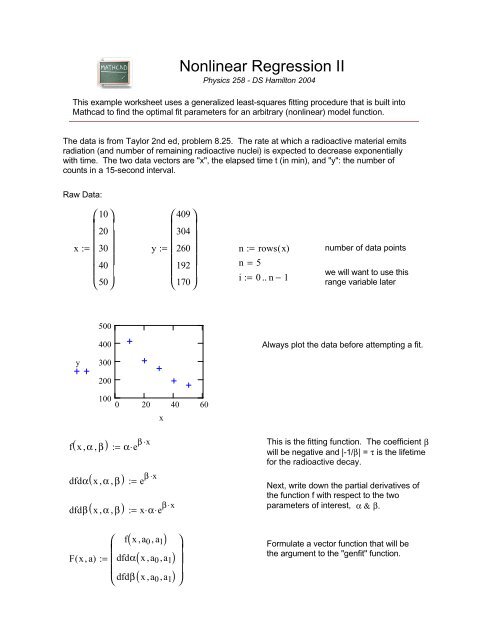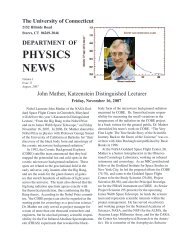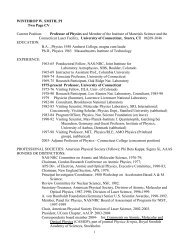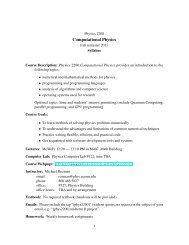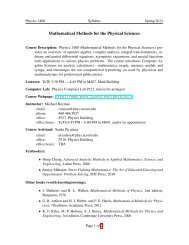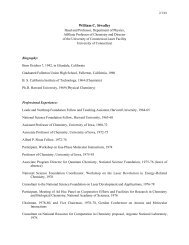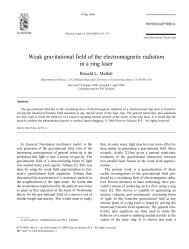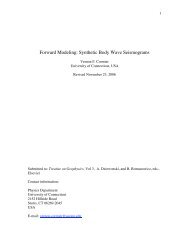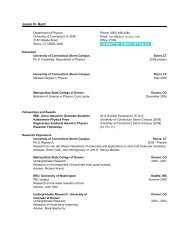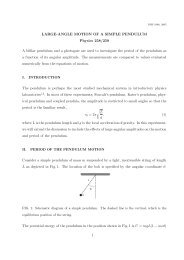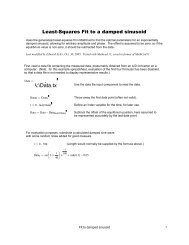Mathcad - genfit.mcd
Mathcad - genfit.mcd
Mathcad - genfit.mcd
Create successful ePaper yourself
Turn your PDF publications into a flip-book with our unique Google optimized e-Paper software.
Nonlinear Regression II<br />
Physics 258 - DS Hamilton 2004<br />
This example worksheet uses a generalized least-squares fitting procedure that is built into<br />
<strong>Mathcad</strong> to find the optimal fit parameters for an arbitrary (nonlinear) model function.<br />
The data is from Taylor 2nd ed, problem 8.25. The rate at which a radioactive material emits<br />
radiation (and number of remaining radioactive nuclei) is expected to decrease exponentially<br />
with time. The two data vectors are "x", the elapsed time t (in min), and "y": the number of<br />
counts in a 15-second interval.<br />
Raw Data:<br />
x :=<br />
⎛<br />
⎜<br />
⎜<br />
⎜<br />
⎜<br />
⎜<br />
⎝<br />
10<br />
20<br />
30<br />
40<br />
50<br />
⎞<br />
⎟⎟<br />
⎟<br />
⎟<br />
⎟<br />
⎠<br />
y :=<br />
⎛<br />
⎜<br />
⎜<br />
⎜<br />
⎜<br />
⎜<br />
⎝<br />
409<br />
304<br />
260<br />
192<br />
170<br />
⎞<br />
⎟⎟<br />
⎟<br />
⎟<br />
⎟<br />
⎠<br />
n :=<br />
n = 5<br />
rows( x)<br />
i := 0..<br />
n − 1<br />
number of data points<br />
we will want to use this<br />
range variable later<br />
500<br />
400<br />
Always plot the data before attempting a fit.<br />
y<br />
300<br />
200<br />
100<br />
0 20 40 60<br />
x<br />
( ) α e β ⋅x<br />
f x, α , β<br />
dfdα x, α , β<br />
dfdβ x, α , β<br />
F( x,<br />
a)<br />
( ) e β ⋅x<br />
( ) := x⋅α<br />
:=<br />
:=<br />
⎛<br />
⎜<br />
⎜<br />
⎜<br />
⎝<br />
⋅<br />
:=<br />
( )<br />
( , , a 1 )<br />
( , )<br />
f x, a 0 , a 1<br />
dfdα x a 0<br />
e β ⋅x<br />
dfdβ x, a 0 a 1<br />
⋅<br />
⎞<br />
⎟<br />
⎟<br />
⎟<br />
⎠<br />
This is the fitting function. The coefficient β<br />
will be negative and |-1/β| = τ is the lifetime<br />
for the radioactive decay.<br />
Next, write down the partial derivatives of<br />
the function f with respect to the two<br />
parameters of interest, α & β.<br />
Formulate a vector function that will be<br />
the argument to the "<strong>genfit</strong>" function.
a :=<br />
⎛<br />
⎜<br />
⎝<br />
500<br />
−0.5<br />
⎞<br />
⎟<br />
⎠<br />
Initial guess for the two parameters. This<br />
is one reason to plot the data first.<br />
⎛α<br />
⎞ ⎜⎝ ⎟⎠ := <strong>genfit</strong>( x, y, a,<br />
F)<br />
β<br />
Call the function "<strong>genfit</strong>" to find the<br />
best-fit coefficients.<br />
The solution is:<br />
α = 505.3 β = −0.023<br />
1<br />
β<br />
= −43.392 These are basically identical to those<br />
found in the "minssd" example.<br />
t := 0, 0.1..<br />
60<br />
Use this dummy variable to plot the fit so that it looks like a<br />
smooth curve through 600 points.<br />
600<br />
500<br />
y<br />
( )<br />
f t , α , β<br />
400<br />
300<br />
200<br />
100<br />
0<br />
0 10 20 30 40 50 60<br />
x,<br />
t<br />
SSD :=<br />
∑ ( y i − f ( x i , α , β ))2<br />
i<br />
SSD<br />
= 10.1<br />
n<br />
This is the RMS difference between the data pints and<br />
the fitting function.


